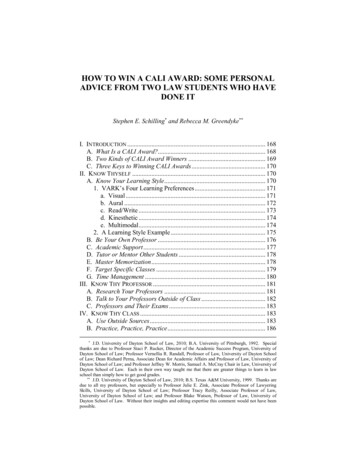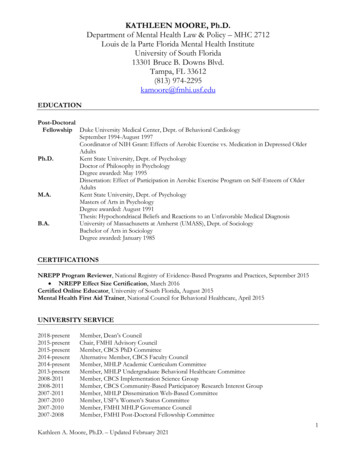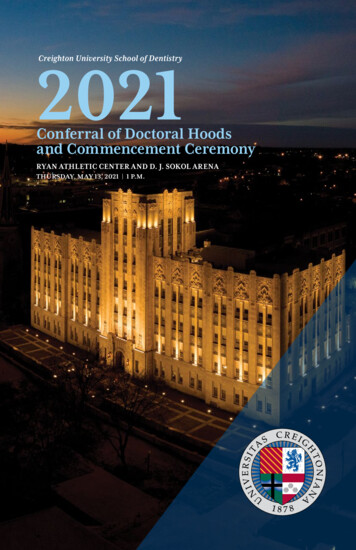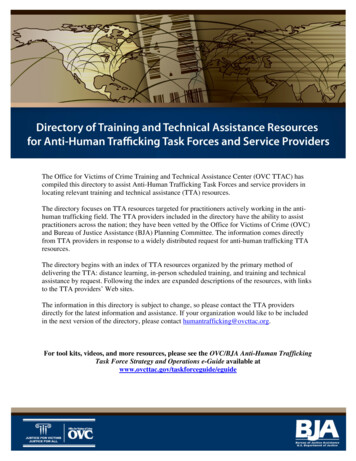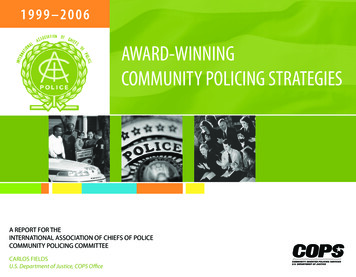
Transcription
1999–2006AWARD-WINNINGCOMMUNITY POLICING STRATEGIESA REPORT FOR THEINTERNATIONAL ASSOCIATION OF CHIEFS OF POLICECOMMUNITY POLICING COMMITTEECARLOS FIELDSU.S. Department of Justice, COPS Office1
ABOUT THE IACPThe International Association of the Chiefs of Police (www.theiacp.org) is the world’s oldest and largestnonprofit membership organization of police executives, with more than 20,000 members in more than 100different countries. IACP’s leadership consists of the operating chief executives of international, federal, state,and local agencies of all sizes.ABOUT THE IACP COMMUNITY POLICING COMMITTEEFollowing the community-policing philosophy of collaborative problem solving, the Committee has a diversemembership. Members include chiefs of police services of various sizes, academics, the private sector andcorrections officials, all of whom are committed strongly to the goals of community policing.ABOUT THE OFFICE OF COMMUNITY ORIENTED POLICING SERVICESThe COPS Office was established as a result of the Violent Crime Control and Law Enforcement Act of1994 to assist law enforcement agencies in enhancing public safety through the implementation of communitypolicing strategies in jurisdictions of all sizes across the country. COPS provides funding to state, local, and triballaw enforcement agencies and other public and private entities to train community policing professionals, acquireand deploy cutting-edge crime-fighting technologies, and develop and test innovative policing strategies. Thisbroad range of programs helps COPS offer agencies support in virtually every aspect of law enforcement, andit’s making America safer, one neighborhood at a time. To learn more information about community policingstrategies such as those discussed in this report please visit COPS Online at www.cops.usdoj.gov.
LETTER FROM THE DIRECTOR OF COPSSince 1995, the U.S. Department of Justice Office of Community Oriented Policing Services (COPS) has workeddiligently to advance the manner in which community policing is practiced at the state and local level throughoutthe nation. COPS has invested 12.4 billion in support of this objective, including grants awarded to more than13,000 state and local law enforcement agencies, training more than 500,000 law enforcement officers and localleaders, and by funding the development of numerous technical assistance resources that seek to increase thebody of knowledge available on critical community policing issues.This report offers a brief description of approaches that have been successfully developed and implemented atthe local level to reduce crime and disorder. We are confident that many of the strategic principles documentedin the report can be modified as needed and adopted by other law enforcement agencies in support oftheir efforts to develop and implement community policing programs that address challenges they may beconfronting.Moreover, the jurisdictions that implemented the approaches detailed in this report should be commended fortheir innovativeness and commitment to community policing. Undergoing the level of organizational changethat is required to shift operational and strategic approaches to proactively fighting crime and disorder canbe among the most significant challenges to successfully implementing comprehensive community policingsolutions. It is no small feat. However, I’m certain that the law enforcement, local government, and communityleaders from the jurisdictions referenced in this report would attest to the benefits of working smarter to fightcrime through community policing.iii
The COPS Office is grateful to the International Association of Chiefs of Police and the IACP CommunityPolicing Committee for their ongoing leadership within the field, and for supporting the good work representedwithin this report. Over the years, their expertise has been a significant contributor to effective communitypolicing, and they have been instrumental in furthering the mission of the COPS Office.Congratulations to the Community Policing Award winners and finalists, and thank you again for yourcommitment to fighting crime and disorder through effective community policing approaches.ivCarl R. PeedDirectorOffice of Community Oriented Policing ServicesU.S. Department of Justice
LETTER FROM THE CHAIR OF THE IACP COMMUNITY POLICING COMMITTEEThe Community Policing Committee of the International Association of Chiefs of Police comprises a dedicatedgroup of police and community professionals who are passionate about community policing and its ability tobuild partnerships, solve problems, and improve quality of life.The call of the Committee is to promote the philosophy of community policing, with its emphasis on initiative,ingenuity, and innovative approaches, among the 20,000 members of the IACP. This is done through variousmeans, including: reviewing and distributing community oriented policing literature, training and researchmaterials; compiling a network of professional law enforcement and academic experts on community policing;establishing links with public and private sector agencies to enhance communication, training and mutualproblem solving; and by identifying, rewarding and portraying as models, agencies that have successfullyimplemented the community policing philosophy.One of the main Committee activities for the past 10 years has been to identify and reward the best practices incommunity policing around the world. To that end, in 1998, the Community Policing Committee and its formerpartner, ITT Night Vision, developed the Community Policing Award to recognize outstanding communitypolicing initiatives by law enforcement agencies worldwide. Since that time, the Committee has reviewedthousands of submissions from communities and agencies all over the world and recognized those that use thepower of partnership to make our local, national, and global communities safer from crime and terrorism.This work is a compilation of the best practices of the more than 50 winners and 150 finalists of theCommunity Policing Award. These best practices cover everything from traffic, gang, and drug problems tohomeland security issues. They provide a viable framework for the delivery of improved police services thatfocus limited resources on issues specific to individual communities, and are also pertinent to all communitiesaround the world.Chief Todd MillerTerrell (Texas) Police ServicesCommittee Chairman
CONTENTAbout the IACP . iAbout the IACP Community Policing Committee . iAbout the Office of Community Oriented Policing Services . iLetter from the Director of COPS. iiiLetter from the Chair of the IACP Community Policing Committee . vIntroduction . 1Summary of Findings . 3Summary of Award Winners and Finalists . . 5Community Policing Strategy Categories and Strategies . 9Problem Solving and Prevention . 10Community Engagement . 11Community Assessment and Engagement . 12Educate the Community . 13Educating the Private Sector . 14Partnerships . 15Partnership with the Community . 15Partnership with Non-Profit Organizations . 17Partnership with Other Public Sector Agencies . 17Partnerships with the Private Sector . 18Task Forces . 19Organizational Development and Change . . 21Program and Resource Development . 21Training and Cross-Training . 22Strategic Planning . 23Use of Civilian Volunteers . . 23vii
Align Officer Performance Measures .Leadership and Risk Taking .Organizational Change.Analysis, Measurement and Evaluation.Community Policing Strategies by Region .West Region .Southwest Region .Midwest Region . .Southeast Region .Northeast Region . .International Region . .List of Award Winners and Finalists .viii242526283131323334303637
INTRODUCTIONSince 1998, the IACP Community Policing Committee has presented the annualCommunity Policing Award to recognize the efforts of police departments in advancingcommunity policing. This year, the members of the committee chose to highlight someof the most innovative approaches used by police departments from 1999 – 2006. Afterreviewing the profiles of 103§ United States and International IACP community policingaward winners and finalists, a number of community-policing strategies§§ were identifiedas constructive elements in advancing local community policing efforts in these agencies.This report organizes each strategy into one of five major community policing strategycategories, and provides a brief description of each of the major community policingstrategy categories and individual strategies, as well as several examples of how someIACP Community Policing Award winners and finalists utilized the strategy in theircommunity policing efforts. Finally, graphs and charts illustrate the use of eachcommunity policing strategy by category and by region.This purpose of this report is to highlight the noteworthy work of the IACP CommunityPolicing Award winners and finalists, as well as to inform law enforcement executivesand others about innovative means to advance community policing and ensure safercommunities for their residents.One hundred-threeaward winners and finalistsprofile were analyzed forthis report. To avoid usingrepeat submissions, only97 profiles are included inthis report.§Departments alsocombined individualstrategies intocomprehensive efforts.§§
SUMMARY OF FINDINGSThe results of the review of the 103 winners and finalists from 1996 to 2006 (see Figure1) found the following: An overwhelming majority of departments included in this report combined multiplestrategies for a comprehensive community policing approach. Resource and program development was the most frequent community policingstrategy employed by the winners and finalists of the IACP Community PolicingAward. Local police departments partnered with a variety of organizations and in the privateand nonprofit sectors: including hospitals, mental health professionals, and localbusiness owners.§ Other police departments partnered with public sector entities,such as social service agencies, local legislators, and others. The majority of the departments included in this report used some type or form ofanalysis, measurement, or evaluation to support their local community policing efforts.Whether implementing community assessments, conducting crime analysis, hostingfocus groups, completing formal evaluations, or conducting surveys, these analyseslead to them developing more informed approaches to reducing crime and disorderproblems. Another segment of the award winners and finalists focused on organizationaldevelopment and change. These local police departments incorporated individualcommunity policing strategies such as strategic planning, program development, usingcivilian volunteers, training and other targeted community policing efforts.The award winners andfinalists used the words“collaboration” and“partnerships”.§
Local police departments also utilized a series of problem solving and prevention oriented communitypolicing strategies. Among the individual community policing strategies used were Crime PreventionThrough Environmental Design (CPTED), and Problem Oriented Policing (POP)and the SARA (Scanning,Analysis, Response, and Assessment) model. A moderate number of the award winners and finalists identified community engagement as a primaryelement in their community policing strategy. These departments completed community assessments,educated segments of the community including both the public and private sectors, and engaged communitymembers in crime prevention efforts.
SUMMARY OF AWARD WINNERS AND FINALISTSNinety-seven different local police departments, from 1999 to 2006, provided the results for our analysisdiscussed and illustrated in this report. Figure 1 illustrates the number of award winners and finalists in eachyear.Figure 1 - IACP Community Policing Committee Award Winners and Finalists 1999-200616Award Winners and Finalists1412 108642019992000200120022003200420052006
Of the individual jurisdictions (states), California had the most number of award winners and finalists.International jurisdictions together (Northern Ireland, United Kingdom, India, Bahamas, and Canada)represented the second largest jurisdiction type (see Figure 2).Figure 2 - Community Policing Award Winners and Finalists by U.S. StatesStateConnecticutIowaKentucky MissouriNevadaNew JerseyNew MexicoOklahomaSouth CarolinaArkansasIllinoisMarylandMichiganNew YorkUtahVermontWisconsinArizonaGeorgia# Award Winners/Finalists1111111112222222233State# Award sota344North CarolinaTexasU.S. TerritoriesVirginiaFloridaInternational JurisdictionsCalifornia444571315
The West region of the United States represented the largest group of community policing award winners andfinalists (25), as illustrated in Figure 4. The West and Southeast regions of the U.S. together represented morethan half of the award winners and finalists.Figure 3 - Community Policing Award Winners and Finalists by Region252015WestSoutheastMidwestInternational Regions10NortheastSouthwest50U.S. Territories
COMMUNITY POLICING STRATEGY CATEGORIES AND STRATAGIESThis report organizes the 22 individual community-policing strategies into five categories: (1) Problem Solvingand Prevention, (2) Community Engagement, (3) Partnerships, (4) Organizational Development and Change, and(5) Analysis, Measurement, and Evaluation.Figure 4 illustrates the total number of times each community policing category was used by award winners andfinalists from 1999 – 2006.Figure 4 - Summary of Community Policing Strategy Categories200150Problem Solving andPreventionCommunity Engagement100500PartnershipsOrganizational Developmentand ChangeAnalysis, Measurement andEvaluation
Problem Solving and PreventionProblem Solving and Prevention represented the smallest of the community policing strategy categories.Although a small category, departments utilized important and proven community policing strategies such asCrime Prevention Through Environmental Design (CPTED), Problem Oriented Policing (POP) and the SARA(Scanning, Analysis, Response, and Assessment) model, and the review and adjustment of local ordinances. The Ontario (Canada) Provincial Police coordinated a task force of police, residents, government agencies,and insurance companies following the Problem-Oriented Policing – Problem Identification – Analysis– Response – Evaluation (POP-PARE) problem-solving model to address issues relating to vehicle-deercollisions that had resulted in approximately 1,000,000 in damages.10 The Halton (Ontario) Regional Police Service implemented S.A.R.A. (Scan Analyze Respond Assess) toaddress and ultimately solve a variety of crime and disorder issues, including an escalating crisis of drugtrafficking, riots, social disorder, vehicle thefts, and damage to property within a five-block area. Afterimplementing an array of response activities such as using volunteers, security staff, bike officers, and tacticalunit operations, the department identified a 75 percent decrease in crime relating to assaults, stolen autos,thefts, mischief, parking complaints, damages, littering, and calls for service.
Figure 5 illustrates the number of award winning and finalists’ local police departments the used ProblemSolving and Prevention in their community policing efforts.Figure 5 - Problem Solving and PreventionNo. of Departments32Ordinance Review/AdjustmentCPTED1POPSARA0Community EngagementCommunity Engagement represented the second smallest of the community policing strategy categories, withjust 8 percent of the award winners and finalists employing these strategies. The community policing strategiesemployed under this category included community assessments and engagement, and efforts to educatemembers of the public, private, and non-profit communities.11
The strength of this strategy is the value of information collected from residents and other stakeholders aboutthe issues and concerns of the community that can help inform police activities that are best suited to addressthese concerns.Community Assessment and EngagementIn 2004, more than one-third of the police department award winners and finalists used community assessmentand engagement as a community policing strategy as an effective means of addressing community concerns.Overall, this individual strategy represented 71 percent of the entire category. Below are some of the efforts oflocal departments using this strategy: The Mound (Minnesota) Police Department gives out “Citizen Comment Cards” in traffic contacts andother calls for service and conducts door-to-door surveys of residents.12 In Texas, to engage the community, the Highland Village Police Department (HVPD) developed the “PoliceInvolving Parents Program,” whereby parents, teens, and police partner in response to the specific infractionto develop an appropriate, parent-enforced punishment. The Pueblo of Santa Ana’s high volume of transient traffic, large number of national events and highprofile infrastructure made it vulnerable to terrorist attacks. After September 11, the Santa Ana TribalPolice Department refocused on the importance of community policing to deter crime and ease fears of thecommunity. The department’s efforts included participating in community events, raising the visibility of thedepartment, partnering with public and private organizations and sponsoring training activities. As a result,community confidence and preparedness increase, and communication are stronger between communityleaders and public safety officials.
Educate the CommunityLocal police departments used educating the community as a tool in advancing community policing. Througheducation, community members become knowledgeable about crime-prevention techniques, police efforts, andbecome better able to act as a partner in crime prevention and reduction efforts with law enforcement. The North Little Rock (Arkansas) Police Department developed a training and public awareness programcalled “Meth Aware.” Working in partnership with local businesses selling ephedrine/pseudoephedrine,the Department developed brochures, educational videos, public service announcements, and billboardsto educate the public about the dangers of such chemicals. In addition, the Department also successfullyinitiated legislation limiting the quantity of products containing ephedrine/pseudoephedrine that can bepurchased in a single transaction or possessed at one time. In Florida, the Boca Raton Police Department (BRPD) discovered that due to an increase in the elderlypopulation, and a concentration of people over the age of 80 in the city, those vulnerable adults were atan increased risk to become victims of crime. The BRPD recognized a need for education that led to theformation of an innovative new outreach program, entitled “The Elder Education Seminar,” a series ofpresentations designed to inform both the elderly and their families about challenges faced by the elderlycommunity. In Texas, the Carrollton Police Department (CPD) launched a multifaceted campaign that focused oneducating citizens and making neighborhood environments less conducive to crime. Officers alerted citizensthrough roadside reader boards, educational pamphlets, and “report cards,” patrolling the hardest-hit areasand grading cars for ease of burglarizing.13
Educating the Private SectorEducating the private sector (restaurants, hotels/motels, or insurance companies) can significantly aide lawenforcement in deterring criminal behavior and further expand the breadth of any community policing effort.Members of the private sector, also, share the benefits of community preservation with residents and local lawenforcement. The Silverthorne (Colorado) Police Department implemented alcohol-server training for local businessesand opened lines of communication with local restaurant owners. As a result, the number of arrests of DUI(Driving Under the Influence) significantly declined from 167 in 2001 to 17 in 2002. In 2005, the Ocean City (Maryland) Police Department created a specialized training called “TeachingEffective Alcohol Management” or TEAM, for wait staff at local restaurants and other businesses cateringto seasonal patrons.Figure 6 - Community Engagement25Police Departments14Figure 6 illustrates the number of award winning and finalists’ local police departments the used CommunityEngagement in their community policing efforts. Although occurring less often, education of the communityand public sector play a large role in addressing crime and disorder.20Community Assessmentand Engagement15Educate Community10Educate Private Sector501999–2006
PartnershipsPartnerships represent the third largest community policing strategy category used by award winners and finalistsfrom 1999 - 2006. Whether through a community organization or a community representative, partnerships withthe community are a valuable strategy in community policing and is at the core of the philosophy. Partnershipsare a vital element in the most effective and comprehensive community policing efforts.Within the partnership category, local departments both strategically and effectively coordinated their effortswith a variety of organizations representing the public, private, non-profit sectors. Several of these partnershipsoperated as both local and regional task forces to address specific issues of crime and disorder.The individual partnership community policing strategies used by award winners and finalists includepartnerships with the community (including the faith community), non-profit organizations, and other publicagencies within their own communities. Some examples of these partnerships are identified below.Partnership with the CommunityPartnerships with the community represented 19 percent of all partnerships, the second most widely used of thevarious strategies within the partnership category. Ten of the fifty-three departments using this strategy soughtstrategic and effective relationships to support their community policing efforts. The following are examples ofhow departments used partnerships as an effective community policing strategy: Police at the University of North Carolina at Chapel Hill established a pedestrian safety committee andbegan addressing pedestrian concerns. The Tempe (Arizona) Police Department (TPD) partnered with citizens representing business, education,faith, fire, police, elected officials, utility companies, neighborhood watches, emergency services, healthcare,and the local university to form the citizens Corps Council.15
The Police Service of Northern Ireland (PSNI) partnered with local government agencies and citizens toidentify, remove and destroy unlicensed vehicles, called “runabout” vehicles (cars stolen for a joy ride orolder cars not properly registered). Community groups, such as “Families Bereaved through Car Crime,”joined the effort by lobbying for funding and creating understanding around the personal impact of suchcrimes. Three state prisons are located in Mansfield, Ohio. Unfortunately, a high number of convicts remain inthe area after incarceration and engage in unlawful behaviors after their release. To address increasingcrime rates, the Mansfield Division of Police (MPD) created the Community Policing Probation/ParolePartnership, which focuses on ensuring that released prisoners follow their parole restrictions. Thepartnership includes visits to local bars, home checks for curfew violations, fugitive surveillance, andprobation/parole officer ride-alongs to familiarize patrol officers living and working in each zone.16 In New York, the New Rochelle Police Department (NRPD) partnered with community leaders and clergyto develop the “Citizens for a Better New Rochelle” to facilitate a mutually respectful relationship betweenthe police and the community through open lines of communication and cooperation. In Boston, Massachusetts, the BPD developed the “Boston Re-Entry Initiative” in partnership with faithbased, community, and criminal justice agencies to help former prisoners adjust to life in their communities. The Boston Police Department also participated in a collaborative effort between clergy and lawenforcement that made unofficial visits to the homes of troubled youth.
Partnership with Non-Profit OrganizationsPartnerships with non-profit organizations were the smallest of the partnership strategies, representing just 4percent of the category. The following are examples of how departments used partnerships with non-profitorganizations as a part of their community policing strategy: The Richmond (Virginia) Police Department partnered with health care providers to establish a collaborativeviolence-prevention effort called “Cops and Docs Working Handcuffed-in-Glove to Reduce ViolenceGroup.” The Mundelein Police Department in Mundelein, Illinois formed a number of partnerships with a variety oforganizations in the community. The partnerships resulted in the development of a number of communitypolicing programs: Project C.A.P.E. (Creating A Positive Environment), the Mundelein Task Force, and thedevelopment of 2 Community Resource Centers. The Youth Service Providers Network (YSPN) is a partnership between the BostonPolice Department and Boys & Girls Clubs of Boston. The YSPN pairs police stationbased social workers with front-line police officers to provide alternatives to thejuvenile justice system though intervention services.The Pasadena PoliceDepartment saved almost2,400 hours of patrol timethrough a partnership withthe Homeless OutreachPsychiatric EvaluationUnit.Partnership with Other Public Sector AgenciesWith nearly every local police department realizing that it cannot fight crime and address community issuesalone, many are reaching out to their
such as social service agencies, local legislators, and others. The majority of the departments included in this report used some type or form of analysis, measurement, or evaluation to support their local community policing efforts. Whether implementing
